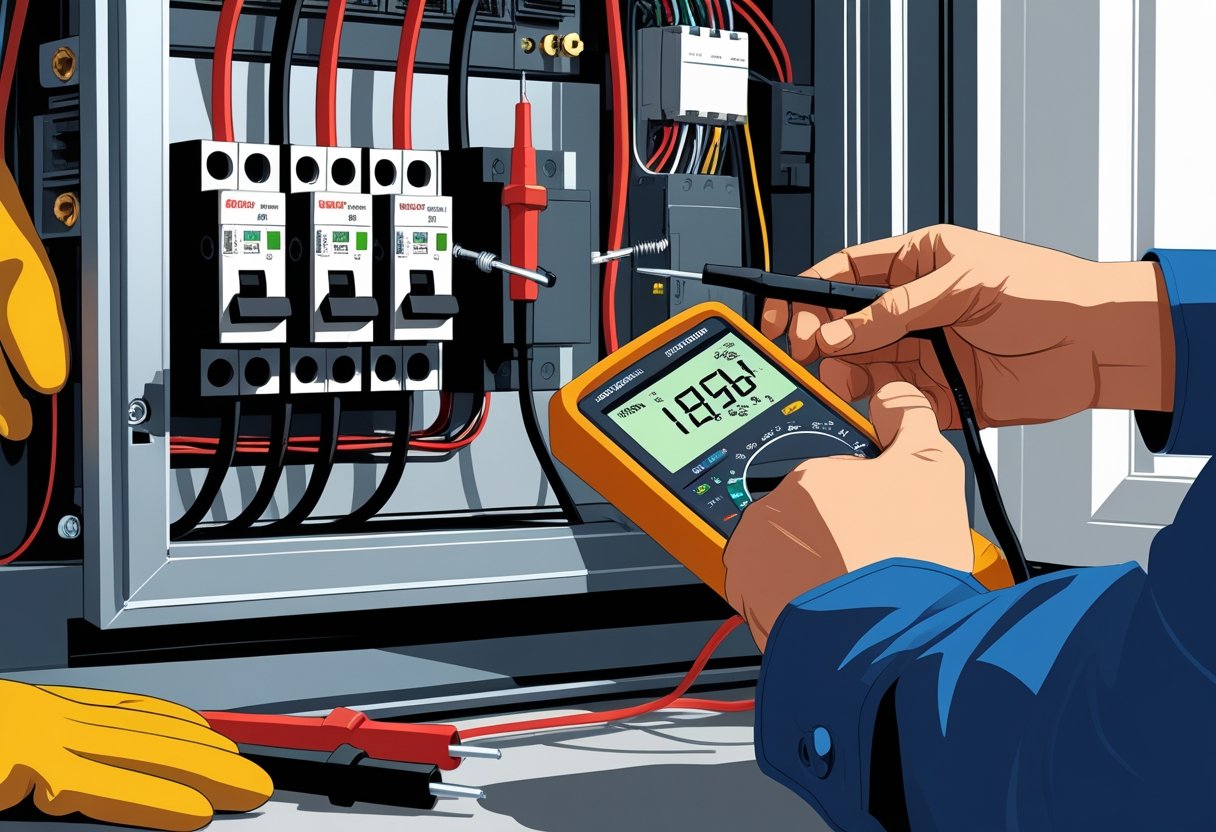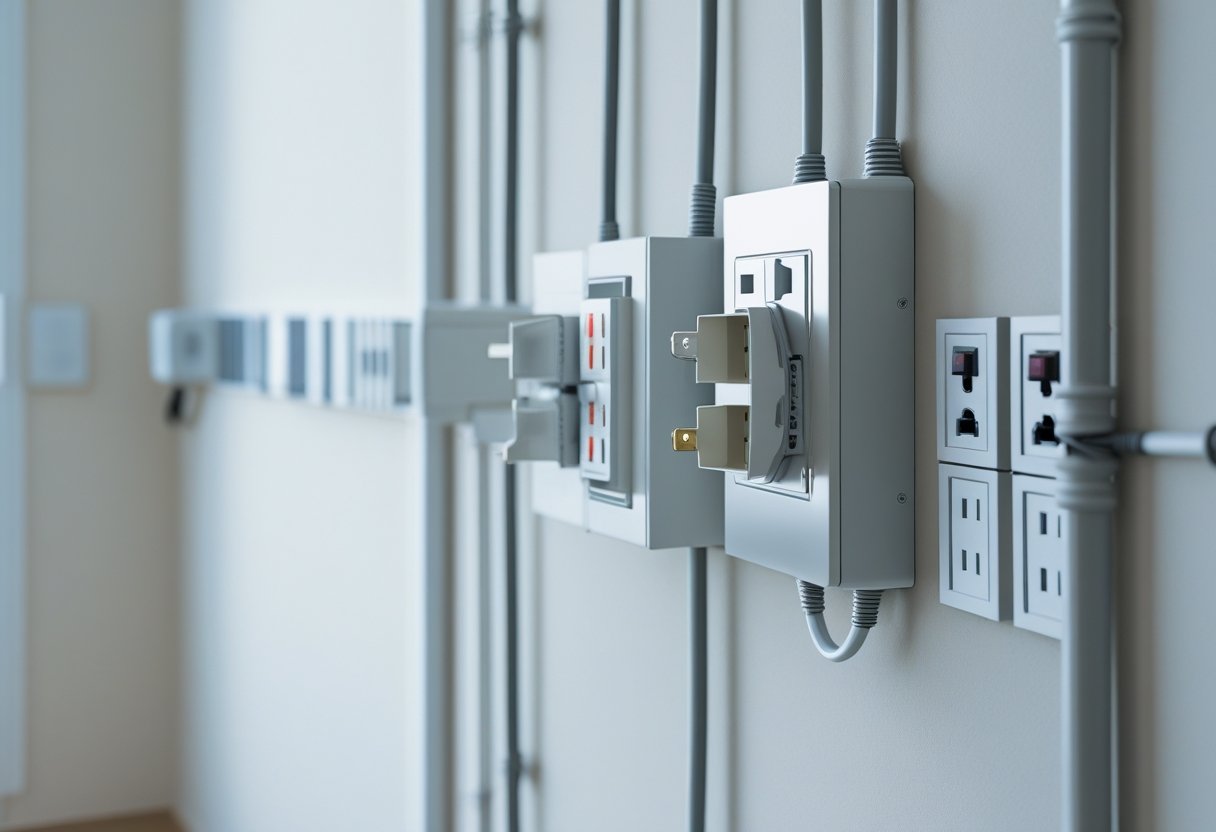If your circuit breaker keeps tripping or you suspect it’s not working properly, testing it can help identify the issue before it becomes a bigger safety concern. You can test a circuit breaker using a multimeter to check for voltage and ensure it’s functioning correctly, which protects your home and family from electrical hazards. This straightforward process can save you time and prevent unnecessary service calls.
At AAA Electrical Services, we understand the importance of safe and reliable electrical systems, especially for families in Sacramento and surrounding areas. With over 40 years of experience, our fully licensed technicians provide fast, same-day service and honest pricing, so you know you’re getting trusted expertise whenever you need it. Knowing how to test your circuit breaker gives you peace of mind and helps keep your home’s electrical system safe.
Whether you’re troubleshooting on your own or planning to call a professional, learning how to test a circuit breaker is a valuable skill. It’s a key step in maintaining your home’s safety and ensuring your electrical system performs as it should without interruption.
Understanding Circuit Breakers and Their Importance
Circuit breakers are essential components in your home's electrical system that prevent damage and hazards by managing electrical flow. Knowing their function and the reasons for regular testing helps protect your family and property from electrical faults.
What Is a Circuit Breaker?
A circuit breaker is an automatic electrical switch designed to interrupt current flow in case of overload or short circuit. It acts as a safety device, stopping excessive current from causing damage to your wiring, appliances, or even starting fires.
Typically found inside your circuit breaker panel or breaker box, these switches reset after tripping, unlike a fuse, which must be replaced. Recognizing a breaker’s role ensures you understand why its reliable operation is critical.
Functions Within an Electrical Panel
The circuit breaker panel is the central hub connecting your home’s electrical circuits to the main power supply. Each breaker corresponds to a specific circuit, distributing power safely throughout your house.
When a fault occurs, the breaker trips, cutting off power to prevent electrical hazards. This isolation protects both your electrical system and household members from shocks or fire risks caused by overheating wires or faulty devices.
Why Regular Testing Matters
Testing your circuit breakers regularly ensures they function properly when needed. Breakers can fail due to wear, dust, or internal mechanical issues, which reduces their ability to trip during faults.
A malfunctioning breaker can cause prolonged power to a faulty circuit, increasing fire and equipment damage risks. Skilled companies like AAA Electrical Services provide thorough circuit breaker testing and repairs to maintain your breaker box’s safety and reliability in Sacramento and surrounding areas. Regular checks provide peace of mind and protect your home’s safety.
For detailed information on testing requirements, visit this guide to circuit breaker testing.
Essential Tools and Safety Precautions
Before testing a circuit breaker, you need the proper equipment and must follow strict safety measures. This includes gathering specific tools, wearing appropriate protective gear, and carefully handling the electrical panel cover. These steps help prevent injury and ensure accurate testing.
Tools Required for Testing
You will need a digital multimeter, which is essential for measuring voltage, continuity, and resistance. Ensure the multimeter is working correctly and set to the appropriate range for testing circuit breakers, usually the AC voltage setting.
Other important tools include a screwdriver to remove panel screws safely and needle-nose pliers to handle wires if necessary. A flashlight can help you see inside dim panels. Avoid using tools that are not insulated or designed for electrical work.
Having the right tools ready reduces testing time and improves safety. AAA Electrical Services always uses a fully stocked “warehouse on wheels” to ensure efficient repairs during same-day service visits.
Personal Protective Equipment
When testing breakers, wear insulated gloves rated for electrical work to protect against shocks. Safety glasses shield your eyes from sparks or debris. Non-conductive shoes or boots prevent grounding yourself unintentionally.
Avoid wearing loose clothing or jewelry that might catch on wires or conduct electricity. Always work in a well-lit, dry environment and have a clear exit path. If you're unsure or uncomfortable, contacting a licensed professional is the safest choice.
AAA Electrical Services prioritizes your family's safety by following these personal protective measures during every service call.
Installing and Removing the Panel Cover
Before touching anything inside the breaker panel, turn off the main power switch if possible. Use a screwdriver to carefully remove the panel cover screws and lift off the cover without applying force to avoid damaging components.
Place the panel cover in a safe spot where it won’t fall or be damaged. When installing it back, align it properly and tighten the screws securely but not excessively.
Never remove the panel cover or attempt testing without understanding the potential risks. Many circuit breaker issues can be complex, so having a licensed technician handle the panel protects your home and wellbeing.
For advice or professional testing in Sacramento and surrounding areas, AAA Electrical Services stands ready with a team trained to deliver safe, transparent, and expert service.
Warning Signs and Common Causes of Faulty Circuit Breakers
Knowing when a circuit breaker is faulty can protect your home from electrical hazards and costly repairs. Understanding what causes breakers to fail helps you identify issues before they escalate. Watch for specific symptoms and conditions that indicate a need for repair or replacement.
Signs of a Faulty or Broken Circuit Breaker
Frequent tripping is the most obvious sign of a faulty circuit breaker. If your breaker trips repeatedly under normal electrical loads, it may not be able to handle the current properly.
Other signs include burning odors near the breaker panel, outlets or breakers that feel unusually warm to the touch, and flickering or dimming lights. These symptoms suggest internal damage or wear.
Visible damage such as scorch marks or cracks around the breaker also signals a problem. If your breaker fails to reset or causes power outages unexpectedly, professional inspection is necessary to ensure safety.
Typical Causes of Circuit Breaker Failure
Circuit breakers can fail due to age, mechanical wear, or electrical faults. Most breakers have a lifespan of 30 to 40 years but can degrade sooner if exposed to regular overloads.
Corroded or loose connections inside the panel may cause the breaker to trip unnecessarily or lose its ability to trip, leading to dangerous conditions. Physical damage from moisture or pests can also impair breaker functionality.
Other causes include defective wiring and environmental factors such as extreme heat or humidity. Regular maintenance and timely repairs from certified technicians like AAA Electrical Services help avoid unexpected breakdowns and keep your home safe.
Understanding Electrical Overload and Tripped Breakers
An electrical overload happens when the demand on a circuit exceeds its designed capacity. This causes the breaker to trip as a safety measure to prevent overheating or fire.
If multiple devices cause the same breaker to trip, it often indicates an overloaded circuit rather than a breaker defect. Conversely, if one device trips several breakers in different outlets, the device itself may be faulty.
Tripped breakers are normal during heavy use, but frequent or unexplained tripping points to a problem in either the breaker or the home's wiring. Proper diagnosis and repair protect your family and prevent power outages.
For reliable circuit breaker repair and same-day service in Sacramento and surrounding areas, you can trust AAA Electrical Services. Their experienced technicians prioritize your family’s safety with transparent pricing and fast fixes backed by decades of expertise.
Step-by-Step Guide: How to Test a Circuit Breaker
Testing a circuit breaker requires careful preparation, accurate measurement, and correct interpretation of your results. You’ll use a digital multimeter to check voltage presence, continuity, and resistance to ensure the breaker is functioning safely and correctly in your electrical system.
Preparation and Initial Visual Inspection
Before you start testing, turn off the main power at your panel to prevent shock. Use a non-contact voltage tester to confirm no power is flowing.
Inspect the breaker visually for signs of damage, burning, or corrosion. Check the breaker switch position—tripped breakers often sit halfway between ON and OFF.
Ensure the panel cover is removed safely and that you understand the breaker layout and the location of the neutral bar. Labeling breakers will keep track of which circuit you’re testing.
Wear insulated gloves and stand on a dry surface. If unsure about any step, call AAA Electrical Services for a safety-first approach to your home’s electrical maintenance.
Testing Voltage with a Multimeter
Set your digital multimeter to the AC voltage setting before testing. Turn the main breaker back on.
Test voltage by placing one multimeter lead on the circuit breaker’s screw terminal and the other on the neutral bar. A properly working breaker should read close to your supply voltage (typically 120V or 240V depending on your system).
If you get no voltage or a fluctuating reading, the breaker may be faulty or the circuit disconnected. Always double-check by testing a known live breaker first.
Never touch bare wires during testing. Maintain steady contact and read your multimeter carefully to avoid misinterpretation.
Checking Resistance or Continuity
Turn off the power again before testing resistance or continuity. Set your multimeter to the resistance or continuity mode.
Remove the breaker from the panel if possible for accurate testing. Place one lead on the breaker terminal and the other on its output side. A low resistance or a beep indicates the breaker is allowing electrical flow.
If the multimeter reads infinite resistance or no continuity, the breaker has likely failed internally.
Continuity testing confirms if the breaker’s internal switch closes properly, which is critical for circuit protection and home safety.
Interpreting Results Accurately
Voltage reading close to your system voltage means the breaker can conduct electricity. No voltage could indicate a tripped breaker or an internal fault.
Continuity presence means the breaker passes current in the ON position. No continuity or infinite resistance usually means the breaker is defective.
If you observe inconsistent readings or frequent tripping, the breaker may need replacement. Avoid guessing; when in doubt, rely on professional inspection.
AAA Electrical Services provides trusted, same-day diagnostics and repairs in the Sacramento and surrounding areas, ensuring your family’s safety with honest, transparent service.
When to Seek Professional Help
Some electrical issues are straightforward, but others can quickly become dangerous or cause more damage if mishandled. Knowing when to call a licensed professional is crucial to protect your home and family while ensuring the problem is fixed correctly.
Identifying Tasks for a Licensed Electrician
If your circuit breaker trips repeatedly despite resets, or if you notice burning smells, scorching, or sparks near your panel, these signs indicate problems beyond DIY repair. Overloaded circuits, short circuits, or ground faults require proper diagnosis and repair by a licensed electrician.
Installing or replacing breakers also demands professional expertise. An electrician will match the breaker’s amperage to your system’s requirements, preventing improper installation that could lead to system failure or fire hazards. AAA Electrical Services offers same-day service with fully certified electricians trained to handle these repairs safely in Sacramento and surrounding areas.
Working Safely with Complex Breaker Panels
Modern homes often have advanced breaker panels with multiple circuits and integrated safety devices. Navigating these systems without experience can risk electrocution, damage to the panel, or incorrect wiring.
Professionals use specialized tools and follow strict safety protocols to avoid injury and electrical hazards. Attempting to test or replace breakers in complex panels without this knowledge creates unnecessary risks. Relying on a licensed electrician ensures the work complies with local codes and maintains your home’s safety. Their “warehouse on wheels” approach allows for quick repairs with stocked parts, minimizing downtime and inconvenience.
Frequently Asked Questions
Testing and maintaining your circuit breakers ensures your electrical system stays safe and reliable. Knowing what tools to use, how to identify issues, and taking proper safety measures will help you handle common breaker problems effectively.
What tools are required to test a residential circuit breaker?
You will need a digital multimeter to check voltage, continuity, and resistance. Additionally, a screwdriver may be necessary to access the breaker panel safely. Insulated gloves and safety glasses are recommended for protection.
Can you explain the steps to check if a circuit breaker has tripped?
First, turn off and unplug all devices on the circuit. Open the electrical panel and locate the breaker. If it’s in the middle position or off, switch it fully off and then back on to reset. If it won’t reset, the breaker may be faulty.
What safety precautions should be taken before testing a circuit breaker panel?
Always turn off the main power supply before opening the panel. Use insulated tools and wear protective gear like gloves and safety glasses. Avoid touching any exposed wiring or metal parts to reduce the risk of electric shock.
How can you test a circuit breaker that's installed in a generator?
For generator breakers, first ensure the generator is off and disconnected from all loads. Use a multimeter to check voltage output at the breaker terminals. Testing continuity across the breaker when it is off can confirm if it has tripped internally.
What are the common indicators of a faulty circuit breaker?
Frequent tripping without apparent cause, inability to reset, burning smells, or visible damage are signs of a bad breaker. Loud noises or a breaker that feels warm to the touch during normal operation also indicate potential failure.
How frequently should circuit breakers be tested for reliability and safety?
Testing every six months is a good standard to ensure functionality. Check breakers immediately if you notice unusual behavior like frequent trips or failure to reset. Regular inspections by licensed professionals add an extra layer of safety.
For expert assistance in testing or repairing your breakers, AAA Electrical Services offers fast, safe, and reliable service across Sacramento and nearby communities. Their fully certified technicians prioritize your family’s safety with transparent pricing and same-day repairs.





